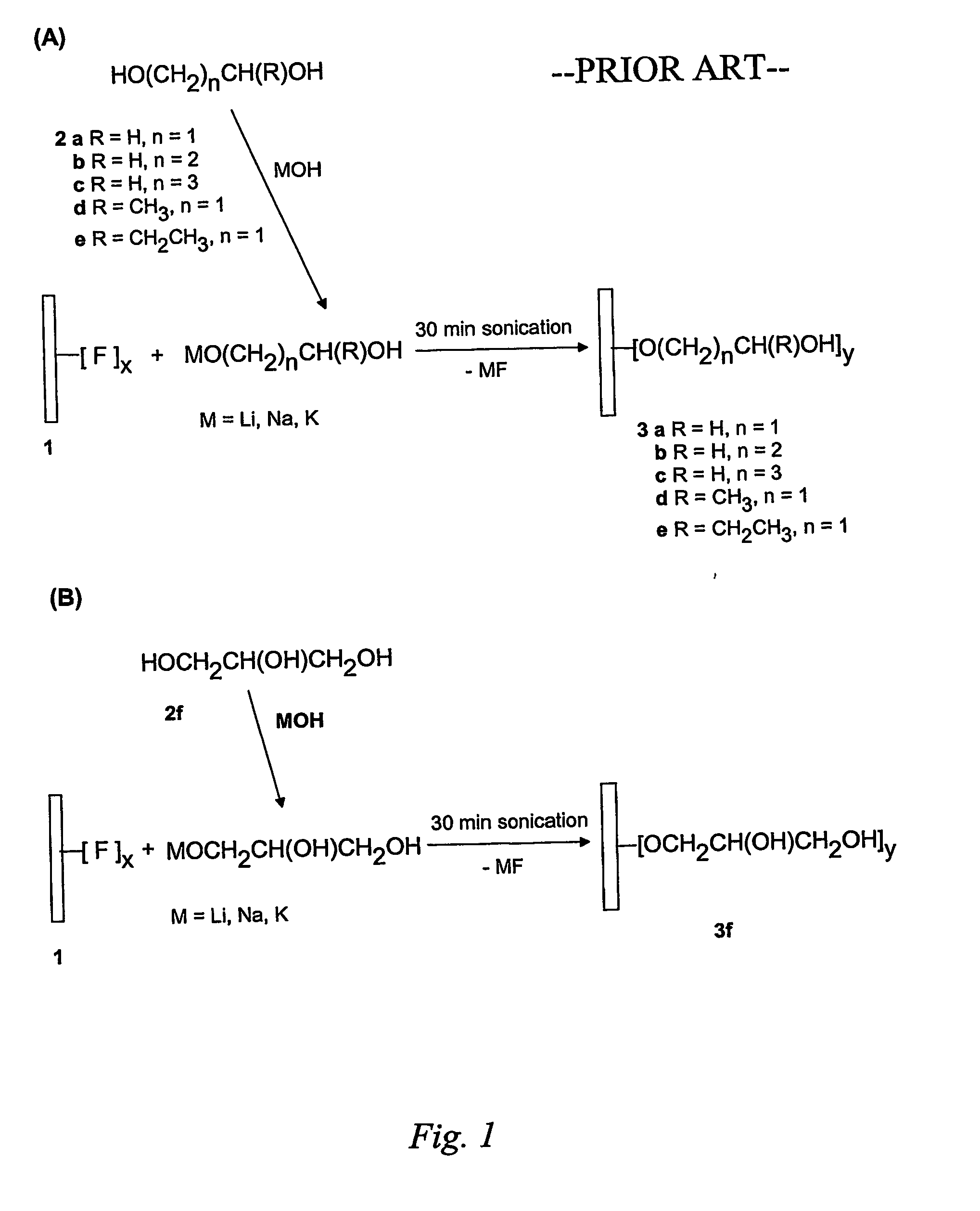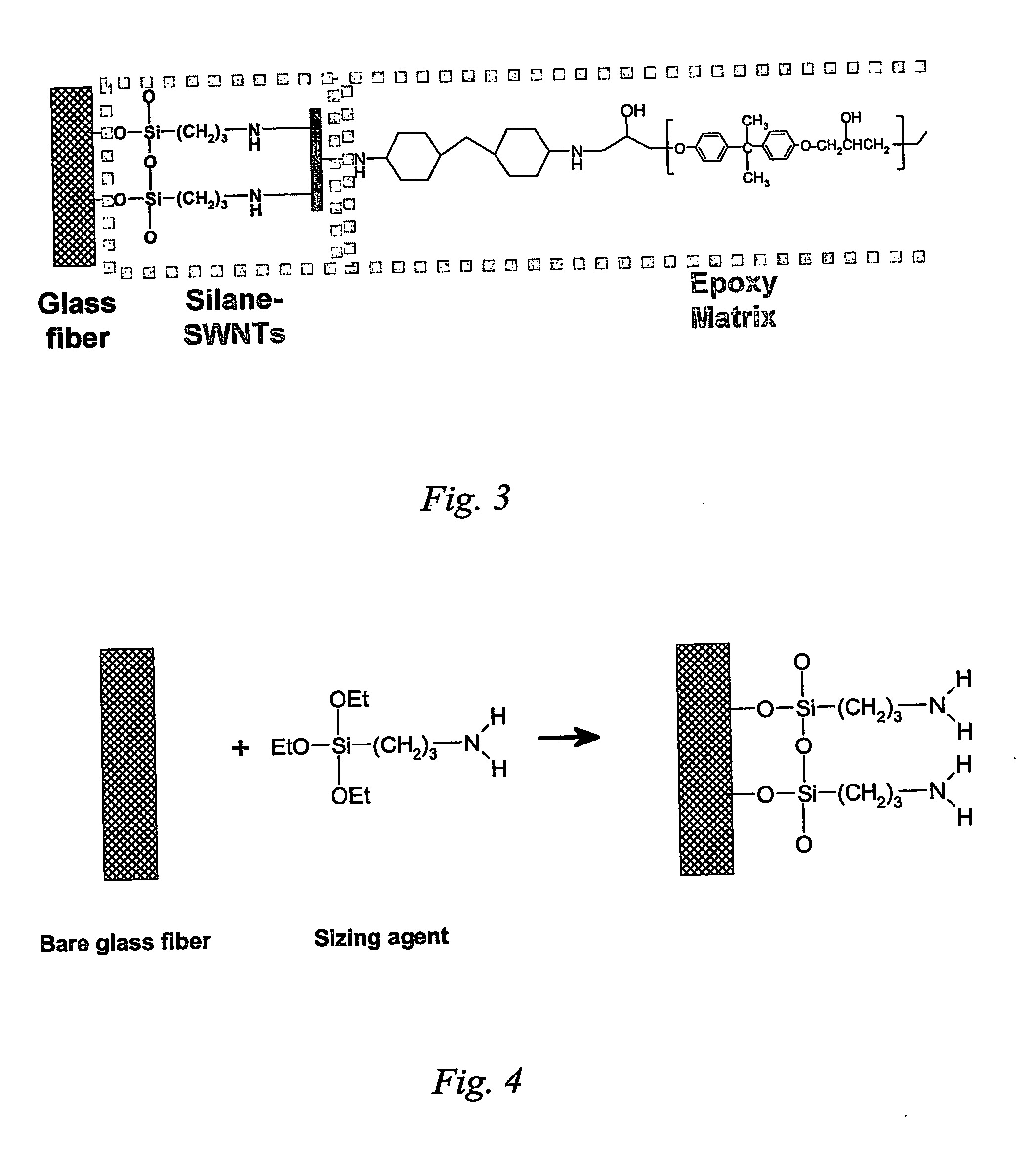Sidewall Functionalization Of Carbon Nanotubes With Organosilanes For Polymer Composites
a carbon nanotube and polymer composite technology, applied in the field of carbon nanotubes, can solve the problems of debundling the nanotubes for homogeneous dispersion, poor dispersion within the polymer matrix, and limited reinforcement role of nanotubes in composites
- Summary
- Abstract
- Description
- Claims
- Application Information
AI Technical Summary
Benefits of technology
Problems solved by technology
Method used
Image
Examples
example 1
[0105] This Example serves to illustrate the fluorination and subsequent hydroxylabon of CNTs. Purified SWNTs were fluorinated to yield “fluoronanotubes” using a procedure developed at Rice University [Mickelson, E. T.; Huffman, C. B.; Rinzier, A. G.; Smalley, R. E.; Hauge, R. H.; Margrave, J. L. Chem. Phys. Lett. 1998, 296, 188; Chiang, I. W. Ph.D. Thesis, Rice University, Houston, Tex., 2001]. The fluorination was carried out in a Monel reactor heated at 150° C. for 12 hours. The gas flow ratio for fluorine, hydrogen and helium was 2:1:30. Then, hydroxylated nanotubes were prepared through reaction of lithium hydroxide treated ethylene glycol with fluoronanotubes (FIG. 1) with two hours of sonication. See commonly-assigned co-pending International Patent Application entitled, “Sidewall Functionalization of Carbon Nanotubes with Hydroxyl-Terminated Moieties,” filed Jun. 16, 2004 (Atty. Dkt. No. 11321-P073WO), as well as in L. Zhang et al., Chem. Mater., 2004, 16, 2055-2061.
example 2
[0106] This Example serves to illustrate the silation of hydroxyl-functionalized CNTs. A hydroxyl functionalized SWNT solution was diluted with water and filtered using 0.2 μm pore size PTFE membrane filter, and flushed several more times with water and ethanol to eliminate un-reacted residue. The hydroxyl-functionalized nanotubes were then dispersed in ethanol solution again (1 mg / 1 ml) with the aid of sonication. Acetic acid was added to adjust the pH value to 5. Then, a silane coupling agent was added to the mixture to form a 0.2% ethanol solution. The mixture was sonicated for 1 hour in a 40 KHz bath sonicator. The solution was dried at room temperature to evaporate off ethanol and heated at 110° C. for 2 hours for postcure. Finally, the silane-functionalized SWNTs were dissolved into acetone with applied sonicaton to wash off any unreacted silane. Such silane reactions on a nanotube surface is shown in Scheme 3.
where Y represents organofunctional groups such as amino, epoxy,...
example 4
[0110] This Example serves to illustrate the dynamic mechanical analysis of CNT-polymer composites of the present invention. The reinforcing role of nanotubes for composite applications strongly depends on the extent of load transfer between the matrix and nanotubes. Several epoxy nanotube composites were fabricated, and their mechanical properties characterized, in a manner similar to that described in previous work [J. Zhu, J. Kim, H. Peng, J. L. Margrave, V. Khabashesku, E. V. Barrera, Nano Lett. 2003, 3, 1107]. In this Example, however, the curing cycles were extended to 12 hours. The various materials tested were: pure epoxy, epoxy with pristine SWNTs and silane additive, epoxy with 1 wt % hydrolyzed nanotubes, and epoxy with 1 wt % silane-functionalized nanotubes. The direct effect of functionalized nanotubes on the mechanical properties of the polymer has been evaluated by Dynamic Mechanical Analysis (DMA), which gives the temperature-dependent properties of materials, such a...
PUM
| Property | Measurement | Unit |
|---|---|---|
| weight percent | aaaaa | aaaaa |
| weight percent | aaaaa | aaaaa |
| temperature | aaaaa | aaaaa |
Abstract
Description
Claims
Application Information
 Login to View More
Login to View More - R&D
- Intellectual Property
- Life Sciences
- Materials
- Tech Scout
- Unparalleled Data Quality
- Higher Quality Content
- 60% Fewer Hallucinations
Browse by: Latest US Patents, China's latest patents, Technical Efficacy Thesaurus, Application Domain, Technology Topic, Popular Technical Reports.
© 2025 PatSnap. All rights reserved.Legal|Privacy policy|Modern Slavery Act Transparency Statement|Sitemap|About US| Contact US: help@patsnap.com



